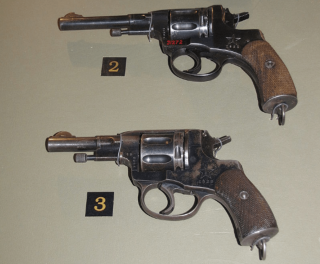Meet the Russian Nagant Gun—the First Silenced Revolver
Prepare to say "Dasvidaniya."
When it was introduced in 1895, the Russian Nagant revolver was quite unique in a number of ways. It was a seven-shot handgun, produced in both double- and single-action versions, it was developed for Imperial Russia by Belgian industrialist and “friend” of the Imperial court Léon Nagant and it used a proprietary 7.62x38mmR cartridge that featured a distinct “gas-seal” system. That latter aspect of the weapon allowed it to be suppressed—which made the Nagant M1895 the first revolver that could be equipped with a “silencer” type device.
Nagant, who had achieved success with solid frame double action revolvers, previously worked with Captain Sergei Ivanovich Mosin of the Imperial Russian Army to develop the Model 1891 Mosin-Nagant bolt action rifle—which would go on to be used in countless wars for well over a century. Moreover, the 7.62x54mmR, which was developed for use in the M91 Mosin-Nagant, has remained one of the few standard-issue rimmed cartridges still in military use, while it has the longest service life of all military-issued cartridges in the world and shows no signs of going away.
How much actual input Nagant had on the Mosin-Nagant remains a point of debate, but he was an established firearms designer—one who has even been compared to American gun designer John Browning—and his work gave him an “in” with the Czar’s ordnance office. Reportedly even Czar Nicholas II took a liking to Nagant’s revolutionary design. The Czar, along with many of the European nobility, had a fascination with firearms but more importantly he tended to favor modern and forward-thinking designs, which he believed could give Russia an advantage on the battlefield.
The fact that the Nagant revolver held seven shots, at a time when most service revolvers held five or six rounds, may have sounded like a great idea to the Czar and his sycophant military advisors. The court may have found the notion that the Nagant revolver was produced in a double action model for officers and a single action model for the ranks (called the “private’s model”) appealing as well. It was a weapon that showed proper class distinction.
Yet, the most distinguishing feature of the M1895 Nagant was its gas-seal system, which moved the cylinder forward when the gun was cocked, closing the gap between the cylinder and barrel. The revolver was chambered for that aforementioned proprietary cartridge, which itself was unique in that the cartridge featured a projectile that was deeply seated entirely within the cartridge case. By sealing the gap in this way, the velocity of the bullet was increased by as much as fifty to one-hundred-and-fifty feet per second.
While the concept of sound suppressors—often referred to today as “silencers”—were in their infancy in the 1890s, it isn’t likely that Nagant’s goal was to actually suppress the sound, but rather his gas-seal design was a clever effort to increase the weapon’s velocity. This may seem needlessly complicated, but it actually worked well even if it did require a special cartridge. Moreover, the Nagant was still built with Russian soldiers in mind, meaning that a hammer was often the only tool available to repair anything!
Despite the fact that it may have sounded like a forward-thinking weapon to the court, it was largely obsolete by the time it was adopted. By the outbreak of the First World War, automatic pistols such as Germany’s Luger and the American Colt M1911 .45 pistol had been introduced—yet the Imperial Russian military stuck with the Nagant.
Ironically, the weapon that found favor with Czar Nicholas II was also used to execute him along with his wife, son and daughters in July 1918. The M1895 Nagant was carried by both the Reds and Whites in the Russian Civil War, and even remained in production after the Communists came to power—but interestingly after 1918 it was only produced in the double action version. Whether that was a result of “class warfare” or just as a way to simplify the production is a matter of debate.
Perhaps because it was the gun that was used to kill the Czar, it was a favored weapon of the Cheka, NKVD and later the KGB—all of which used silenced Nagant revolvers in various clandestine operations. Suppressed versions were later used by the Viet Cong to carry out assassinations during the Vietnam War. The latter fact highlights that while it was a largely antiquated design when it was introduced, its distinct attributions still made it a favored weapon in covert operations decades later.
Peter Suciu is a Michigan-based writer who has contributed to more than four dozen magazines, newspapers and websites. He is the author of several books on military headgear including A Gallery of Military Headdress, which is available on Amazon.com.
Image: Wikimedia

